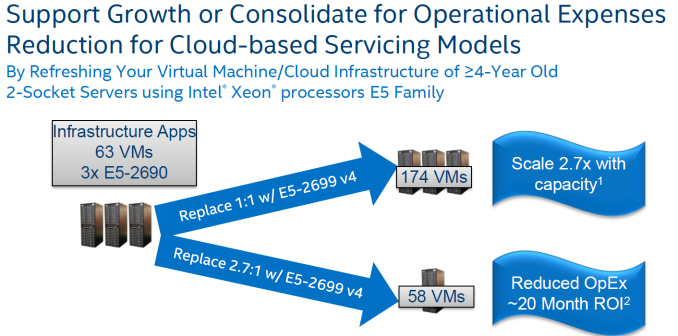The Intel Xeon E5 v4 Review: Testing Broadwell-EP With Demanding Server Workloads
by Johan De Gelas on March 31, 2016 12:30 PM EST- Posted in
- CPUs
- Intel
- Xeon
- Enterprise
- Enterprise CPUs
- Broadwell
Closing Thoughts
With the limited amount of time we had to spend with the new Broadwell-EP Xeons ahead of today's embargo, we spent most of our time on our new benchmarks. However we did a quick check on power as well. It looks like both idle power and load power when running a full floating point workload have decreased a little bit, but we need to do a more extensive check to further confirm and characterize this.
Meanwhile, considering what a wonderful offering the Xeon E5-2650L v3 was, it is a pitty that Intel did not include such a low power SKU among our samples for review. The Xeon E5-2699 v4 is a solid product, but it's not a home run. Either this is just an hiccup of our current setup (firmware?), but it seems the new Xeon E3 v4s do not reach the same turbo speeds as our Xeon E5 v3s. As a result, single threaded performance is (sometimes) slightly slower, and the new processor needs more cores to beat the previous one.
We noticed this mostly in the HPC applications, where the new Xeon is a bit of mixed bag. Still, considering that 72 to 88 threads are a bit much for lots of interesting applications (Spark, SQL databases...) there is definitely room for processors that sacrifice high core counts for higher single threaded performance (without exagerating). We have been stuck at 3.6 GHz for way too long.
With that said, there is little doubt that the Xeon E5-2699 v4 delivers in the one application that matter the most: virtualization.
Although we have not yet extensively tested on top of an hypervisor, we are pretty sure that the extra cores and the lower VMexit latencies will make this CPU perform well in virtualized environments. Intel's resource director technology and many improvements (posted interrupts) that help the hypervisor to perform better in I/O intensive tasks are very attractive features.
Although it is not much, as compared to the Haswell-EP based Xeon E5 v3s, performance has also increased by about 20% in key applications such as databases and ERP applications. And while we can complain all we want about the slightly regression in single threaded performance in some cases, the fact of the matter is that Intel has increased performance by 2 to 2.7 times in four years in those key applications, all the while holding power consumption at more or less the same. In other words, it will pay off to upgrade those Sandy Bridge-EP servers. And for many enterprises, that is what matters.











112 Comments
View All Comments
ltcommanderdata - Friday, April 1, 2016 - link
Does anyone know the Windows support situation for Broadwell-EP for workstation use? Microsoft said Broadwell is the last fully supported processor for Windows 7/8.1 with Skylake getting transitional support and Kaby Lake will not be supported. So how does Broadwell-EP fit in? Is it lumped in with Broadwell and is fully supported or will it be treated like Skylake with temporary support until 2018 and only critical security updates after that? And following on will Skylake-EP see any Windows 7/8.1 support at all or will it not be supported since it'll presumably be released after Kaby Lake?extide - Friday, April 1, 2016 - link
When MS says they are not supporting Skylake on Windows 7 DOES NOT MEAN it won't work. It just means they are not going to add any specific support for that processor in the older OS's. They are not adding in the speed shift support, essentially.For some reason the press has not made this very clear, and many people are freaking out thinking that there will be a hard break here will stuff will straight up not work. That is not the case.
Broadwell has no new OS level features over Haswell (unlike Skylake with speed shift) so there is nothing special about Broadwell to the OS. As the poster above mentions, they are all x86 cpu's and will all still work with x86 OS's.
The difference here is between "Fully Supported" and Compatible. Skylake and even Kaby Lake will be compatible with WIndows 7/8/8.1.
aryonoco - Friday, April 1, 2016 - link
Johan, this is yet again by far the best Enterprise CPU benchmark that's available anywhere on the net.Thank you for your detailed, scientific and well documented work. Works like this are not easy, I can only imagine how many man hours (weeks?) compiling this article must have taken. I just want you to know that it's hugely appreciated.
JohanAnandtech - Friday, April 1, 2016 - link
Great to read this after weeks of hard work! :-Dfsdjmellisse - Friday, April 1, 2016 - link
hello, i want to buy E5-2630L v4any one can give me website for buy it ?
Best regards
HrD - Friday, April 1, 2016 - link
I'm confused by the following:"The following compiler switches were used on icc:
-fast -openmp -parallel
The results are expressed in GB per second. The following compiler switches were used on icc:
-O3 –fopenmp –static"
Shouldn't one of these refer to icc and the other to gcc?
JohanAnandtech - Friday, April 1, 2016 - link
Pretty sure I did not mix them up. "-fast" does not work on gcc neither does -fopenmp work on icc.patrickjp93 - Friday, April 1, 2016 - link
Um, wrong and wrong. -Ofast works with GCC 4.9 and later for sure. And -fopenmp is a valid ICC flag post-ICC 13.JohanAnandtech - Saturday, April 2, 2016 - link
"-fast" is a typical icc flag. (I did not write -"Ofast" that works on gcc 4.8 too)extide - Friday, April 1, 2016 - link
Johan, if you read the comment, you can see that you mention icc for BOTH.